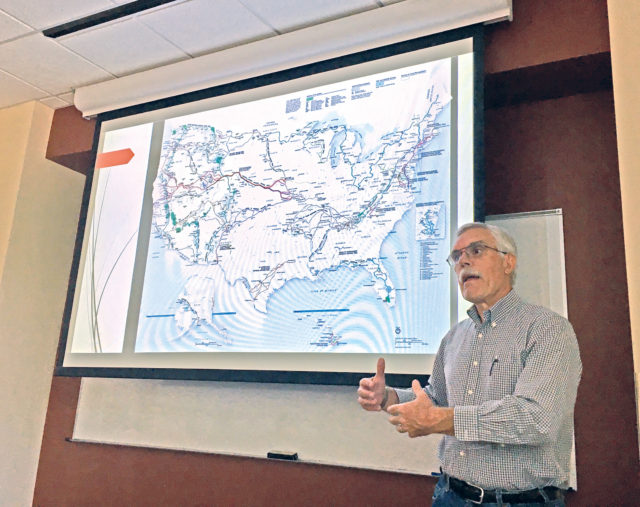by Frank Norris, Angelica Sanchez-Clark, and Jeff Denny, Staff, National Trails Intermountain Region, National Park Service
Reaching new audiences for our national historic trails among a generation eager for something beyond the traditional pioneer narrative is a continuing challenge for trail historians and interpreters across the country. In what may be a first-of-its-kind effort, the National Park Service’s National Trails Intermountain Region (NTIR) staff and the University of New Mexico (UNM) partnered to present a semester-long National Historic Trails course for 18 undergraduate students last fall. By all accounts, it was a resounding success.

Frank Norris, Ph.D. and historian with the National Park Service’s National Trails Intermountain Region, presents the history of national trails to the University of New Mexico class. Photo Credit: NPS
Back in the spring of 2015, NTIR worked with UNM professors from across the academic spectrum to establish a Trails Advisory Committee. Since then, both UNM students and trail resources administered by NTIR have benefited from research projects in the departments of History, Geography, Spanish and Portuguese, Regional Studies, the Honors College, and the School of Architecture and Planning.
The idea for an upper-level undergraduate trails course sprang forth from that underpinning of shared interests. History professor Dr. Fred Gibbs and Ph.D. candidate Guy McClellan designed a 16-week course to provide students with a grounding in the historiography of the American West. Featuring readings and class discussions about Native history, gender, violence, cultural identities, economics, and politics, Gibbs and McClellan hoped students could use the national historic trails to identify and uncover the typically hidden stories beyond the dominant narrative of the westward movement and American expansion.
Eighteen undergrads with majors ranging from history, geography, and anthropology to criminology, geology, and film, participated in the inaugural National Historic Trails course in the fall of 2018. “The success of the course depended on willing students who understood and appreciated the course’s innovative and experimental nature,” Gibbs said.
Although the syllabus had been completed weeks ahead of time, this initial trails course evolved in unexpected ways. As McClellan explained, “The syllabus ended up changing a lot over the semester, but the end goal was always the same: encourage students to think critically about the NTIR-administered historic trails and develop the skills to interpret them for a broader audience.”
After the introductory class sessions, students plunged into the wide-ranging reading lists, often selecting—and debating—articles based on their own specific interests. The academic focus was balanced by visits from NTIR staff who offered real-world perspectives on trail history, interpretation, preservation, and other issues in trail administration.
The second half of the course emphasized the practical research and interpretive skills needed by public historians. Given New Mexico’s location, where the Santa Fe, Old Spanish, and El Camino Real de Tierra Adentro National Historic Trails and Route 66 have significant mileage, most students chose to focus their work on a New Mexico-based trail. Collectively, the students created an impressive online Santa Fe National Historic Trail Historic Sites Travel Itinerary and wrote brief vignettes of personalities—some well known, others less so—associated with various national historic trails. A pragmatic goal for both class projects was the compilation of material that would be peer-reviewed by fellow class members and then placed on a trail-based web page.
For their part, students welcomed the new perspectives on American history available through the lens of our national historic trails. “It is a very different way of thinking about history from what you are taught in other classes. This class overall has changed many assumptions I had about humans and how they experience space and time,” one student remarked. Another said, “It broadened my perspective on public history and how important it is to bring history in the public eye.”
Gibbs plans to teach the course again in the 2019-2020 school year, after which the course will move to another university department, furthering the interdisciplinary goals of the course. “The fact that all students reported a highly positive experience with the course suggests that a National Historic Trails course goes far beyond merely teaching history of trails, but provides an important multidisciplinary venue for expanding students’ conceptions of U.S. history, historical writing, historical interpretation, and public history,” he said.
If interested in developing a similar course, contact NTIR staff or UNM professors: angelica_sanchez-clark@nps.gov or fwgibbs@unm.edu
Unless otherwise indicated, all material in Pathways Across America is public domain. All views expressed herein are perspectives of individuals working on behalf of the National Trails System and do not necessarily represent the viewpoint of the Federal agencies.